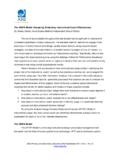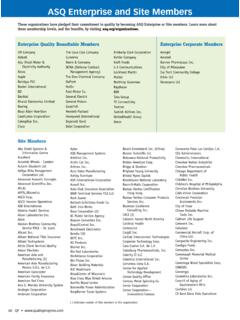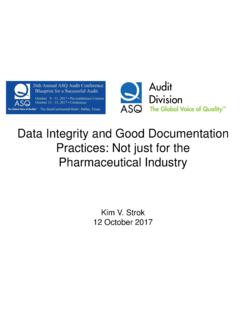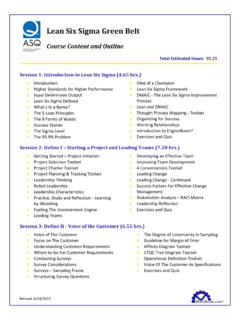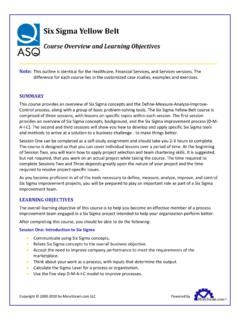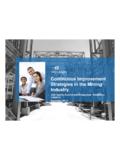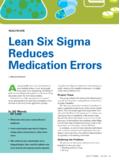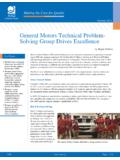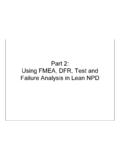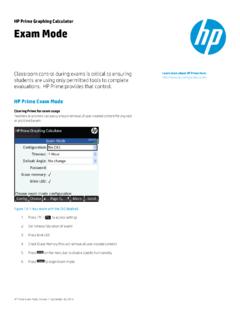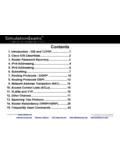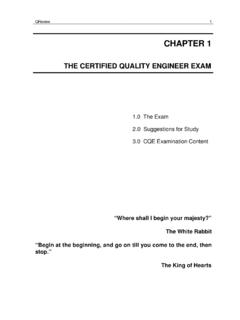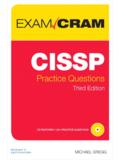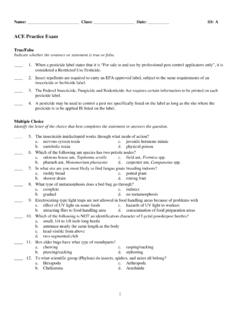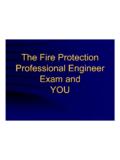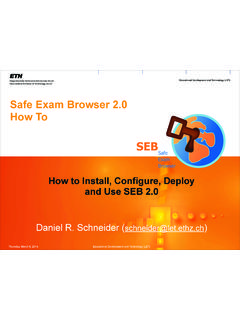Transcription of SAMPLE EXAMINATION examination WILL NOT be …
1 2011 ASQ ASQ grants permission for individuals to use this SAMPLE EXAMINATION as a means to prepare for the formal EXAMINATION . This EXAMINATION may be printed, reproduced and used for non-commercial, personal or educational purposes only, provided that (i) the EXAMINATION is not modified, and (ii) ASQ s copyright notice is included. The user assumes all risks of copyright infringement. SAMPLE EXAMINATION The purpose of the following SAMPLE EXAMINATION is to provide an example of what is provided on exam day by ASQ, complete with the same instructions that are provided on exam day. The test questions that appear in this SAMPLE EXAMINATION are retired from the CQA pool and have appeared in past CQA examinations. Since they are now available to the public, they will NOT appear in future CQA examinations. This SAMPLE EXAMINATION will NOT be allowed into the exam room. Appendix A contains the answers to the SAMPLE test questions. ASQ will not provide scoring and analysis for this SAMPLE EXAMINATION .
2 Remember: These test questions will not appear on future examinations so your performance on this SAMPLE EXAMINATION may not reflect how you perform on the formal EXAMINATION . A self-appraisal of how well you know the content for the specific areas of the body of knowledge (BOK) can be completed by using the worksheet in Appendix B. On page 1 of the instructions, it states There are 150 questions on this 5-hour EXAMINATION . You will receive 2 parts to the CQA exam, (1) multiple-choice questions, (2) Audit Documents for the case study questions. Please note that this SAMPLE exam only contains 80 questions and the 2 parts are combined. Each part does include the same cover letters and page numbering formats as the formal EXAMINATION . If you have any questions regarding this SAMPLE EXAMINATION , please email THIS PAGE WAS LEFT BLANK INTENTIONALLY The following section contains the first part of the CQA EXAMINATION , the multiple-choice questions. NAME_____ CERTIFIED QUALITY AUDITOR Please print your name above.
3 Read all the instructions before beginning the EXAMINATION . If you are unsure about any part of the instructions, consult your proctor. In order for ASQ to be able to properly scan the Scantron answer sheet you must completely fill in the circle. Each circle must be filled in dark enough for the scanner to properly pick up the answer you chose. If not this could result in the exam not being scored correctly, or potentially delay your results. General Instructions All answers must be recorded on the Scantron Answer Sheet; no exam will be graded with the answers marked in the exam booklet. There are 150 questions on this 5-hour exam. You will receive 2 parts to the CQA exam, (1) multiple-choice questions, (2) Audit Documents for the case study questions. 1. Using a soft lead pencil (#2 or softer) only, blacken the circle of the correct answer. Do not use ink. If you change your answer, be sure to erase the previous answer completely. Do not fold, staple, or tear the answer sheets.
4 2. Each question has ONE correct answer only. 3. This is a timed test; do not linger over difficult questions. Instead, skip the questions of which you are unsure; return to them when you reach the end of the test. 4. Although this is an open book EXAMINATION and personally generated materials/notes from training or refresher courses are allowed, the following conditions apply: Each examinee must make his/her reference materials available to the proctor for review. Absolutely no collections of questions and answers or weekly refresher course quizzes are permitted. Reference sources that contain such copy are not allowed unless the questions and answers are removed or obscured. Examples of such sources include but are not limited to refresher and preparatory primers. Calculator Policy: With the introduction of palmtop computers and increasing sophistication of scientific calculators, ASQ has become increasingly aware of the need to limit the types of calculators that are permitted for use during the examinations.
5 Any silent, hand-held, battery-operated calculator WITHOUT an alphabetic keyboard will be permitted; however, all programmable memory must be cleared from the calculator before you enter the exam room. The EXAMINATION is written so that a simple calculator will be sufficient to perform calculations. No laptop or palmtop computers are allowed. No Cell Phones are allowed in exam room Reference materials and calculators may not be shared. 5. When you have finished, check your answer sheet to be sure it is properly identified with your name and member number. Return your EXAMINATION booklet, answer sheet, examinee comment form and scratch paper to your proctor. You must sign the roster sheet to signify the return of your test booklet. 7. It is strictly forbidden to copy or remove EXAMINATION materials. You will be disqualified from the EXAMINATION and not certified by ASQ if you breach this trust. 8. PLEASE BE PATIENT - you will receive your results in approximately two weeks.
6 Sorry, but we do not answer telephone requests for results. If you pass, your certificate will be sent directly to your address of record. If you do not pass, you will receive a Pareto analysis of your test results along with retake information. CQA SAMPLE Exam Special Instructions 1. Please note that your answer sheet has been personalized with your name, member number, section number, and test type. 2. Do NOT make any changes to these parts of the answer sheet. Doing so will only delay your exam results. Notify the Proctor of any changes. 3. If you don t have a personalized answer sheet, see your Proctor for further instructions. 4. There are 150 questions on this 5-hour EXAMINATION . STOP DO NOT CONTINUE UNTIL INSTRUCTED CQA- SAMPLE EXAM CERTIFIED QUALITY AUDITOR Test Directions: Each of the questions or incomplete statements below is followed by four suggested answers or completions. Select the one that is best in each case and then fill in the corresponding space on the answer sheet.
7 3 1. A root cause of a nonconformance is defined as a problem that (A) is discovered by conducting designed experiments (B) is established through the use of fishbone diagrams (C) must be reviewed by the material review board (D) must be corrected in order to prevent a recurrence 2. When lower-tier documents are compared to higher-tier documents before the fieldwork starts, the comparison is called a (A) desk audit (B) process audit (C) conformance audit (D) management audit 3. An audit trail is necessary in order to (A) schedule and budget for audit assignments (B) show how and when items were reviewed (C) provide management with justification for an audit (D) provide the audit manager with audit results 4. Which of the following audit strategies is a common technique to assess compliance to a specific requirement at all locations where that requirement is applicable? (A) Discovery method (B) Element method (C) Department method (D) Process method 5.
8 Which of the following conclusions can be made by an auditor who observes that statistical process control (SPC) charts posted near operator workstations are done correctly and are regularly completed throughout the plant? (A) Commitment of management to quality is strong (B) Processes are being improved continually (C) Shop floor staff have been fully trained (D) SPC charts are available 6. When is it acceptable to grant an extension of the time frame for a corrective action? (A) When the auditor cannot perform the follow-up audit as scheduled (B) When the auditee determines that the proposed corrective action is not cost-effective (C) When the corrective action plan requires more time than originally anticipated (D) When there has been a change in operators who perform the task 7. The fraction of nonconforming products is plotted on which of the following types of control charts? (A) p chart (B) u chart (C) np chart (D) c chart 8.
9 Auditors can use flowcharts in their work in order to (A) analyze the causal factors of process dispersion (B) understand the overall process or system being audited (C) distinguish variations in a process over time (D) determine process capability and uniformity CQA- SAMPLE EXAM 4 9. An auditee responds to a corrective action request by stating that the problem has never occurred before and is not the norm for our operation. Which of the following is the most appropriate action for the lead auditor? (A) Note that the deficiency is the result of a random occurrence. (B) Draft a response explicitly requesting a more concise root-cause analysis. (C) Confer with the audit client to assess the appropriateness of the response. (D) Schedule a follow-up audit immediately. 10. Which of the following is an audit reporting technique for prioritizing audit findings? (A) Weibull distribution (B) Risk-benefit ratio (C) Cognitive dissonance (D) Ishikawa diagram 11.
10 Which of the following is most important for an auditor to convey at an initial audit interview? (A) A give-and-take atmosphere that focuses on compromise (B) A formal approach that is guided by specific roles for each participant (C) An interest in cooperation and open dialogue (D) A personal approach to information gathering 12. If the audit escort for one area is repeatedly late or unavailable, what is the best option open to the auditor? (A) Notify the auditee management of the consequences created by the delays. (B) Narrow the scope of the audit to accommodate the delays. (C) Proceed without the escort. (D) Assess system effectiveness using objective evidence from other areas. 13. Which of the following statistics would best describe the central tendency of a SAMPLE of data? (A) Mode (B) Mean (C) Standard deviation (D) Range 14. During the opening meeting, it is the auditee s responsibility to (A) prepare the meeting agenda (B) set the audit schedule (C) state the audit purpose and scope (D) identify safety requirements 15.
